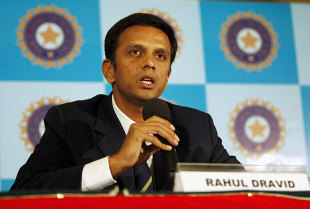The press conference began on schedule and, within three-quarters of an hour, Dravid left the room and international cricket as he had walked in. Swift, smooth, business-like, and, on Friday, to the sound-and-light burst of camera flashbulbs. The significance of Friday's announcement will be understood only six months down the line, when India play Test cricket for the first time in 16 years without the most reliable one-drop in their history.
The decision to retire was not sudden, he said; the period of contemplation had lasted over a year as he assessed his game series after series. The disappointment of the Australia tour had not given him any 'eureka' moment around his decision to leave the game. "I didn't take the decision based on one series… these decisions are based on a lot of other things, it's the culmination of a lot of things. I don't think it's based on what happened in the last series. For each one it comes differently, for me it's come with a bit of contemplation, a bit of thought, with friends and family."

| |||
On his return from Australia, Dravid spent a month, taking out the "emotion" from the overall result in order to "look at things dispassionately," he said. At the end he said, "I came to this decision and when I came to it, I was very clear in my mind." It had, he said, been easy as it was difficult, that he had known "deep down in his heart" that it was time for the "next generation of the young Indian cricketer" to take over.
It was tough to leave "the life I have lived for 16 years and, before that, five years of first class cricket. It [cricket] is all I have known all my grown life … it wasn't a difficult decision for me because I just knew in my heart that the time was right, and I was very happy and comfortable in what I had achieved and what I had done. You just know deep down that it is time to move on and let the next generation take over."
Dravid entered the function room straight into a scrum of photographers, looking almost apologetic at having caused such a fuss. He was dressed in his India blazer and seated on the podium next to BCCI president N Srinivasan and his former team-mate, captain and now KSCA president, Anil Kumble. The walls around him were lined with portraits of Karnataka's Test players, in the front row of the audience were members of his family, team-mates and the cricket community of the city.
He began by reading out his statement, his voice steady as he listed the people who'd played a part in every stage of his career - coaches, selectors, trainers, physios, officials, team-mates, family, even the media. He ended with the Indian cricket fan. "The game is lucky to have you and I have been lucky to play before you… My approach to cricket has been reasonably simple: it was about giving everything to the team, it was about playing with dignity and it was about upholding the spirit of the game. I hope I have done some of that. I have failed at times, but I have never stopped trying. It is why I leave with sadness but also with pride."
With the statement ended and applause breaking out, Dravid looked at his wife in the first row. There was both relief and calm on his face and something other than television lights reflecting in his eyes. After the contemplation and the deliberation, the conversations with people he trusted, it was over.
Dravid became the first of India's senior-most cricketers - Sachin Tendulkar and VVS Laxman being the others - to quit the game after a season of speculation surrounding their future. His decision follows a poor tour of Australia but he enjoyed a prolific run through 2011, scoring five centuries - including four in the Caribbean and England. However, he is set to captain Rajasthan Royals in the upcoming IPL season.

| |||
| | |||
The biggest surprise of the afternoon, however - far more unexpected than even the finality of Dravid's retirement - was to follow. It came from BCCI president N Srinivasan: a man famous for an undemonstrative, glacial public face made an emotional and heartfelt speech. He spoke extempore of an "irreplaceable" cricketer, his voice wavering more than once. Srinivasan recalled having watched Dravid "grow from the days he played club cricket in Chennai, from the Ranji Trophy days … to the time he captained India". Dravid, he said, was an "ambassador for the sport, for the Indian team and for India".
"None of us really want to see such great players go away, we like to think they are permanent," Srinivasan said. "I think that deciding when to retire is possibly the hardest decision Rahul has ever faced. It is not easy to say adieu…"
Kumble called Dravid one of Karnataka's "finest cricketing sons" and spoke of his "reassuring presence" for India in the dressing room and on the field. It was Kumble who got Dravid to eventually crack his first smile of the afternoon, when he said the KSCA would now "expect to see you often in the association wearing the administrative hat." There were also a few tips on life after retirement, Kumble telling Dravid that apart from being busier "with exceptional demands made on your time, your ability to say no will be challenged like never before".
Sitting in the audience was Dravid's former team-mate Javagal Srinath, the current KSCA secretary, who had walked into the room before the event to check if the arrangements were in order. Dravid's immediate future includes six weeks of the IPL and he offered no clues as to whether he would take up a post-retirement life as coach, administrator or commentator. "I truly believe that some time away from the game will be good for me, I've played the game for 20 years I've lived in a cocoon, in a surreal world, this world has been away from reality in some ways." He did say though that because he loved routines, his return to the real world could include his new routines that involve dropping his sons off at school and shopping for groceries.
Among Dravid's contemporaries, both Kumble and Sourav Ganguly retired just after Test matches and Dravid was asked whether he had not wanted to end his career that way, walking off a field of play. "Just to keep playing for the sake of playing just one Test match, I didn't think was right." He needed to play, "for the right reasons - to win Test matches for India. I've done that for 16 years and I feel the time was right, I've had a great run. I have given this some thought … at the end of the day when a player has to go, he knows he has to go and I didn't feel the need to drag it on longer [in order to have a farewell Test]." Dravid was replying to questions in three of the four languages he speaks, taking particular pride in receiving special applause from the back of the room for working his way through a fairly long answer in Kannada.
Along with his wife, sons and brother, Dravid had walked onto the Chinnaswamy field for a short while just before he came in to speak to the media. The stadium was his finishing school before his graduation to Test cricket, and the adjacent NCA nets turned into a trusted training ground over the past decade where Dravid had always showed up early to work on his game.
Now retired, he will finally be free of the 7am gym and nets sessions. But what about the pure love of just batting? Of striking the ball with bat? Wouldn't he want to steal into the nets just for a hit or two? Dravid paused for a moment, smiled and then said: "Probably in the quiet. I'll come very late at night."
On the day he left the international game, this became the perfect final image of Rahul Dravid. Not that of the obdurate competitor in the arclights of cricket's 'surreal' centre. But of the "reassuring presence", of the craftsman in the quiet of dusk, of the man who never stopped trying.





























